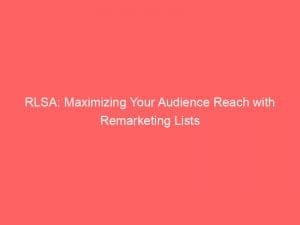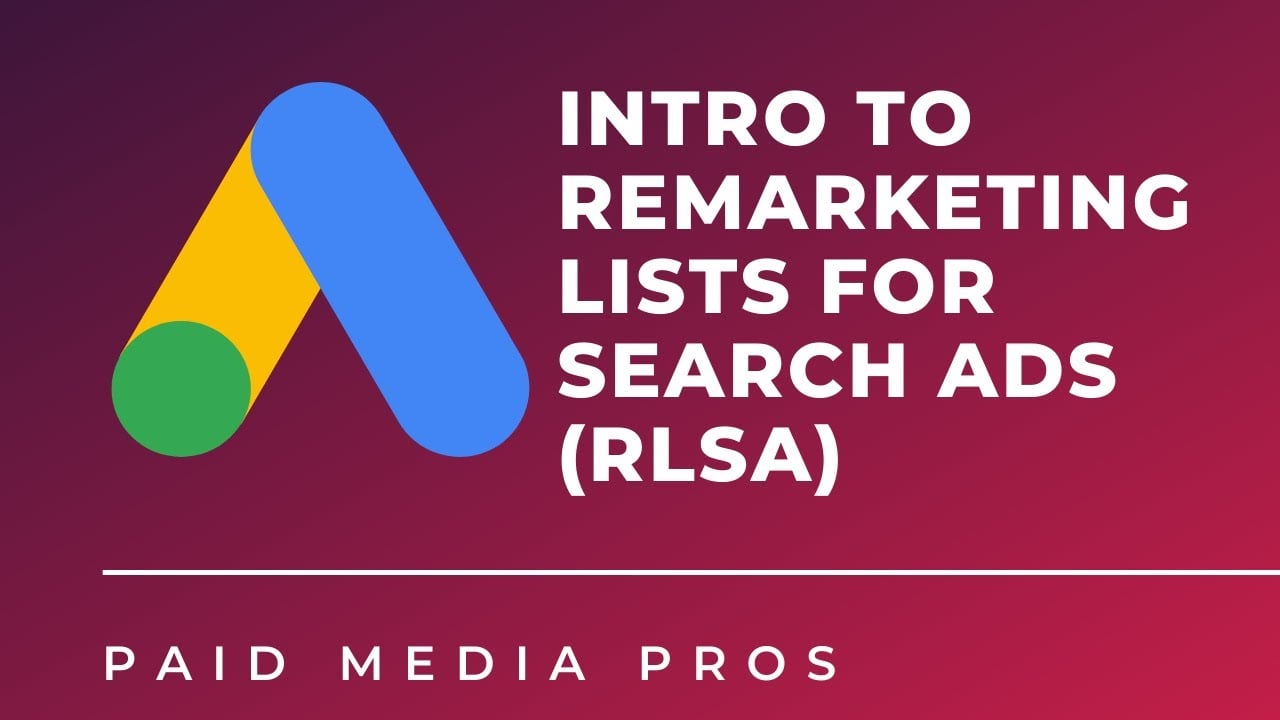Imagine you had the power to advertise only to the people who have already shown interest in your brand. Sounds amazing, right?
Well, with Remarketing Lists for Search Ads (RLSAs), it’s absolutely possible. RLSAs are like a magic wand for marketers, allowing them to target ads specifically to previous website visitors.
By segmenting your audience and making adjustments to bidding, you can unlock a whole new level of marketing optimization. But that’s not all – RLSAs also offer the incredible benefits of enhancing brand retention and driving up sales.
Curious to know the secrets behind this game-changing strategy? Keep reading to find out!
Table of Contents
- rlsa
- RLSAs: Targeting Ads To Website Visitors
- Minimum Cookie Requirement And Membership Limit
- Benefits Of Using RLSAs
- Creating RLSA Campaigns With Google Ads Tag
- Six Tips For Optimizing RLSAs
- Strategies For Demographic Targeting And Monitoring Audience Size
- Importance Of Keyword Research For RLSAs
- RLSAs: Effective For Qualified Leads And Marketing Results
- Technical Requirements And Performance Benchmarks For RLSAs
rlsa
RLSAs, or Remarketing Lists for Search Ads, are a powerful tool that allows advertisers to specifically target ads to users who have previously visited their website. This strategy requires a minimum of 1,000 cookies and a membership limit of 540 days for the lists.
The benefits of using RLSAs are numerous, including keeping the brand in customers’ minds, segmenting audiences effectively, and ultimately increasing sales and ROI. To create RLSA campaigns, advertisers need to tag their website for remarketing using a Google Ads tag.
Additionally, there are several tips for optimizing RLSAs, such as segmenting audiences, tailoring ad copy for returning customers, using negative keywords, adjusting bids for different audience segments, utilizing dynamic search ads, and continuously testing and optimizing campaigns. Furthermore, strategies such as demographic targeting, monitoring audience size, and conducting keyword research are crucial to maximizing RLSA effectiveness.
In terms of technical requirements and performance benchmarks, it is important to stay updated and utilize techniques like bid adjustments, message matching, and negative bids or exclusions. Combining RLSA with Dynamic Search Ads campaigns can lead to even better results, as exemplified by the success of retailer Grainger, who saw significant improvements in key metrics.
Advanced techniques involve creating ad groups based on RLSA lists and leveraging Facebook ads for data collection. Additionally, bidding on low-margin products and targeting users who have completed a purchase for upselling and cross-selling opportunities can be effective strategies.
Finally, the “Bottom Feeding Approach” combines broad match keyword targeting with exact audience targeting to capture leftover search traffic. Overall, RLSAs are highly effective for targeting qualified leads and improving marketing results.Key Points:
- RLSAs are a powerful tool for targeted advertising to users who have visited a website before, requiring a minimum of 1,000 cookies and a membership limit of 540 days.
- Benefits of using RLSAs include brand retention, effective audience segmentation, and increased sales and ROI.
- Optimizing RLSAs involves:
- Segmenting audiences
- Tailoring ad copy
- Using negative keywords
- Adjusting bids
- Utilizing dynamic search ads
- Continuously testing and optimizing campaigns.
- Technical requirements and performance benchmarks include:
- Bid adjustments
- Message matching
- Negative bids/exclusions
- Can be further enhanced by combining RLSA with Dynamic Search Ads campaigns.
- Advanced techniques for RLSAs involve:
- Creating ad groups based on RLSA lists
- Leveraging Facebook ads for data collection
- Bidding on low-margin products
- Targeting users who have completed a purchase for upselling and cross-selling.
- The “Bottom Feeding Approach” combines broad match keyword targeting with exact audience targeting to capture leftover search traffic and improve marketing results.
Sources
https://klientboost.com/google/rlsa/
https://neilpatel.com/blog/rlsa/
https://support.google.com/analytics/answer/6212951?hl=en
https://www.wordstream.com/blog/ws/2016/06/08/rlsa
Check this out:
💡 Pro Tips:
1. Leverage demographic targeting in RLSA campaigns to reach specific audiences based on age, gender, location, and more.
2. Conduct thorough keyword research to better understand user intent and craft highly targeted RLSA ads that resonate with your audience.
3. Implement important technical requirements for RLSA, such as properly tagging your website for remarketing using a Google Ads tag, to ensure smooth campaign execution.
4. Continuously monitor audience size and adjust your RLSA bids based on user behavior to maximize results and increase the efficiency of your campaigns.
5. Combine RLSA with Dynamic Search Ads campaigns to extend your reach and achieve improved outcomes, leveraging the strengths of both strategies.
RLSAs: Targeting Ads To Website Visitors
RLSAs, or Remarketing Lists for Search Ads, are a powerful tool that allow advertisers to specifically target ads to users who have previously visited their website. This form of advertising allows businesses to stay top-of-mind with their potential customers and increase their chances of conversion.
By leveraging user data from their website, advertisers can create tailored ads that resonate with their target audience and increase the likelihood of a sale.
Minimum Cookie Requirement And Membership Limit
To utilize RLSAs effectively, an advertiser needs to have a minimum of 1,000 stored cookies from website visitors. This ensures that there is a sufficient pool of users to target and optimize ad campaigns towards.
Additionally, Google Ads imposes a membership limit of 540 days for these remarketing lists, meaning that users who have not visited the website within this time frame will no longer be included in the targeting pool. This helps keep the remarketing lists up-to-date and relevant.
Benefits Of Using RLSAs
There are several benefits to utilizing RLSAs in advertising campaigns. Firstly, by targeting ads to users who have previously interacted with a brand’s website, businesses can keep their brand in the minds of potential customers.
This increased brand recall can lead to higher consideration rates and improved conversion rates. Additionally, RLSAs allow advertisers to segment their audiences based on their website behavior, enabling more targeted messaging and a personalized user experience.
Finally, RLSAs have been proven to increase sales and return on investment (ROI) for businesses, making it a powerful tool in the marketing arsenal.
Creating RLSA Campaigns With Google Ads Tag
To create RLSA campaigns, advertisers need to tag their website for remarketing using a Google Ads tag. This tag collects data on website visitors and adds them to remarketing lists.
By implementing this tag correctly, businesses can start building their remarketing lists and target their ads towards these specific user groups. Implementing the Google Ads tag may require some technical knowledge, but once properly set up, it lays the foundation for successful RLSA campaigns.
Six Tips For Optimizing RLSAs
Optimizing RLSA campaigns requires strategic thinking and constant refinement. Here are six tips to maximize the effectiveness of RLSA campaigns:
Highlight special offers or exclusive benefits to incentivize them to make a purchase.
Higher bid adjustments can be applied for more valuable segments to increase their visibility.
Test different ad variations, bidding strategies, and targeting parameters to continually improve your results.
Strategies For Demographic Targeting And Monitoring Audience Size
Demographic targeting plays a crucial role in ensuring ads reach the right audience. By understanding the characteristics and preferences of your target audience, you can tailor your RLSA campaigns to resonate with their specific needs and interests.
Monitoring audience size is equally important, as it allows you to gauge the potential reach of your campaigns and adjust your targeting parameters accordingly.
Importance Of Keyword Research For RLSAs
Keyword research is essential for understanding user intent and aligning your RLSA campaigns with relevant search queries. By identifying the keywords your target audience is using when searching for products or services, you can optimize your ad copy and bidding strategies to effectively capture their attention.
Thorough keyword research ensures that your RLSA campaigns are aligned with the needs and interests of your potential customers.
RLSAs: Effective For Qualified Leads And Marketing Results
RLSAs are highly effective for targeting qualified leads and improving marketing results. By targeting users who have already visited your website, you can reach an audience that has already shown interest in your brand or products.
This increased relevance and familiarity increase the likelihood of a conversion and ultimately leads to improved marketing performance. RLSAs can significantly boost conversion rates, increase return on ad spend, and overall, contribute to a more successful marketing strategy.
This post updated with new ad network performance data.
Technical Requirements And Performance Benchmarks For RLSAs
There are certain technical requirements and performance benchmarks that advertisers need to be aware of when utilizing RLSAs. Firstly, the minimum requirement of 1,000 cookies ensures that there is a sufficient number of users to target within a specific remarketing list.
Additionally, ad campaigns should aim for a membership limit of 540 days to maintain an updated and relevant audience pool. Advertisers should continually monitor and optimize their campaigns to meet performance benchmarks and ensure maximum effectiveness.
In conclusion, RLSAs offer advertisers a powerful tool to reach users who have previously visited their website. By targeting ads specifically to these potential customers, businesses can increase brand recall, segment their audiences for personalized messaging, and ultimately drive sales and ROI.
By following the tips for optimizing RLSAs, strategically employing demographic targeting, conducting thorough keyword research, and adhering to technical requirements, advertisers can maximize their audience reach and reap the benefits of remarketing lists for search ads.
Buy Traffic • Performance Marketing Tips • Programmatic Advertising • Self-Serve DSP Platform












